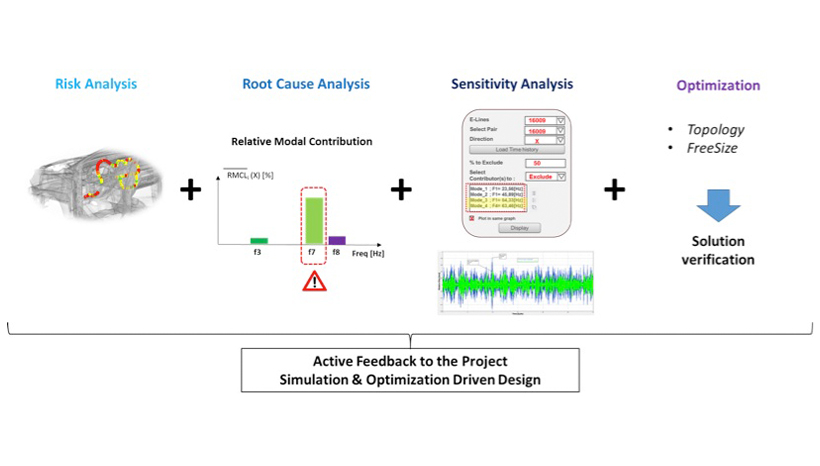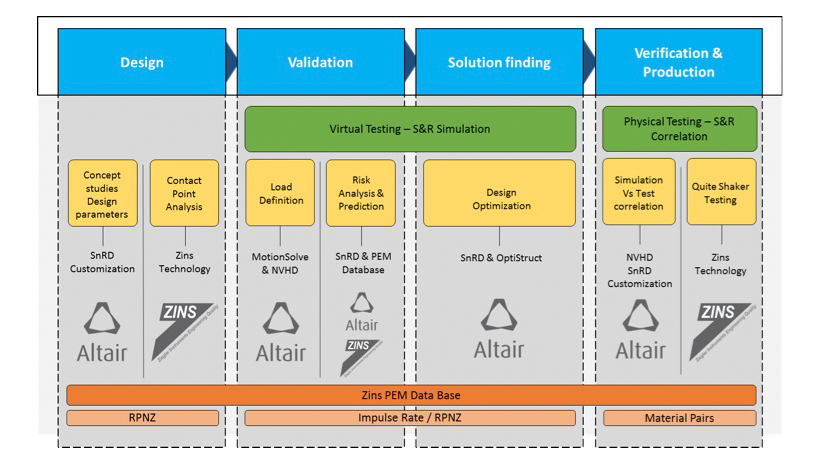Does your car squeak and rattle? Simulation is here to help.
Squeak and Rattle (S&R) noise in vehicle interiors are known to be amongst the most irritating issues for the passenger, causing dissatisfaction and perception of extremely poor build quality. For decades, OEMs and interior suppliers have been well
aware of these issues. Tackling and fixing them have always been a must, but the necessary tools have not always been available and S&R studies remain a pretty niche discipline of the wider noise, vibration and harshness (NVH) domain. S&R
investigations are often pushed to late phases of projects, when prototypes are finally available and physical testing is possible. Mainly using quick fixes with high costs, engineers have had to work as firefighters.
Traditionally, this discipline would have been physically tested, but the necessity for reducing cost and most importantly, for designing right from the beginning, have increased the need and use of a virtual simulation alternative. Today, the
development of well-defined methods and tools for NVH analysis allows OEMs to have a virtual engineering based development cycle from the concept phase all the way through to physical testing.
I first became interested in the subject eight years ago right after my studies, when I performed my thesis work on the “Correlation between Test and Simulation for S&R Problematics”. This in turn led to the co-publication of the E-Line methodology, a best practice described in SAE 2010-01-1423 and SAE 2012-01-1553.
In 2012, I joined Altair where talented people elevated this methodology to the next level and produced the ‘Squeak and Rattle Director’ (SnRD); a simulation based solution for predicting the risk of S&R occurring for trim parts, identifying
the root causes, and proposing solutions to the projects via sensitivity analysis and optimization. This type of simulation integrates Design & Manufacturing Data as well as advanced material testing data for the assessment.
 Courtesy of FIAT Brazil.
Courtesy of FIAT Brazil.
The experience collected over the years have shown the complexity of S&R problems, their causes and consequences. The most critical ones are the variations due to manufacturing and the associated cost like warranty, after works, and tool change. These need to be considered as early as possible.
When designing any assembly, many attributes are dictating the design requirements. When it comes to quality and finish, the gaps and tolerances between the components are critical as S&R phenomena results from components contacting each other under certain vibration loads. Hence, any assembly produced will have a unique set of gaps and tolerance chains. The consequence on S&R testing is critical: testing one or multiple assemblies, like an instrument panel in a car for example, represents only a limited portion of your population. The notion of Robust Design becomes fundamental if the phenomena is to be accurately simulated and eradicated.
The role of an S&R simulation & optimization driven design process is to incorporate the variation in the early stage of the design. The goal is to Do It Right The First Time (DRIFT) and decrease the risk of S&R due to inevitable variations.
Altair’s methods enabled through the SnRD, not only detect the risk areas but also to identify the root cause and quantify this risk in term of Defects Per Units (DPU). This supports the complete organization to prioritize the most critical issues.
My role as Squeak & Rattle Method Developer and Business Developer with Altair is to continuously develop our S&R solutions to meet the needs that our customers have not yet expressed, and most importantly, to help our customers embed this
simulation & optimization driven design process in their existing development cycles. Developing the most robust product means two things: a satisfied customer and a reduced cost of failure.

A solution like SnRD is however only one piece of the puzzle and can’t provide all the answers, we still need engineers with expertise to analyze results and communicate the valuable inputs to the project. For the past couple of years, I have had the chance to execute S&R projects for more than twenty customers worldwide. Each time, our main focus was to change the mentality and adapt the existing processes by implementing a simulation based development process for S&R. This included identifying problem areas at early stages without a physical prototype, providing design guidance to the development program, and eliminating physical testing loops. As a result, we’ve had some excellent early examples of how the S&R solution can have a positive effect on the development of high quality vehicle interiors, including implementations at companies like FIAT and Scania.
We work with our partners like materials specialist, Ziegler, who have 15 years of experience in the field of S&R prediction – to offer a unique combination of expertise, CAE and testing, for the prediction and correction of S&R problems. This enables us to work with our customers at different points of their development cycles, from target definition and material compatibilities to virtual engineering and optimization of the systems they develop, including correlation with testing.
I believe that we’re going to see S&R simulation becoming an ever more important and sought after field within the NVH domain. This is due to two major drivers. Firstly, consumer expectations of high build quality across all vehicle brands will continue to rise and their tolerance of perceived poor workmanship will decrease. Secondly, as the electric car makes its way into the mainstream, their infinitely quieter powertrains will not be able to mask the unappealing noises that would have previously gone unnoticed.
So the next time you get in your car, turn down the radio and see if you can hear anything unexpected, and think about Altair’s team of specialists who are making sure that these issues are gone when it’s time for you to upgrade to a new vehicle.

This post was first published on Automotive Testing Technology International.
Find out more about the Squeak & Rattle Director, and watch the short demo
below:

